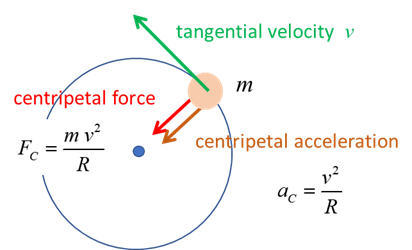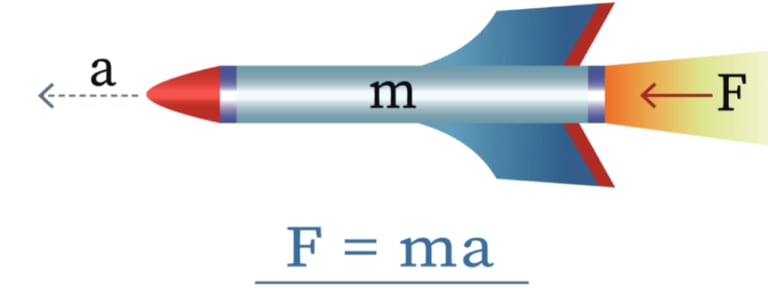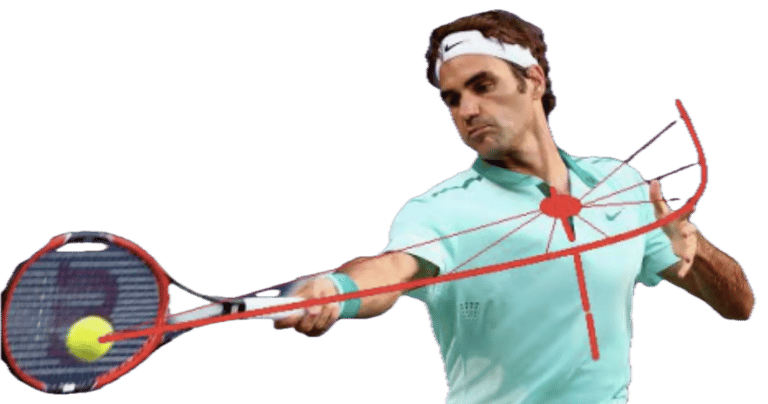Basic Concepts of Newton’s Second Law
When you swing the racket, your body is applying force to accelerate it. The racket head speed at the moment of impact depends directly on how much force you generate and how effectively you continue it through your body structure.
That’s why understanding Newton’s Second Law isn’t just theory—it’s the key to unlocking controlled power in your serve and groundstrokes. Below is the basic concepts of Newton’s second law:
For Linear Motion.
Let’s see what Sir Newton’s second law would say about this:
For linear movement: F = M*A. F is the force added to the object M and A is acceleration
For Circular Motion
But in circular motion, acceleration has a special role: it constantly changes the direction of the object’s velocity to keep it moving along a curve.
This is called centripetal acceleration (center-seeking acceleration).
Because the tennis swing is rotary or circular, we also have to define how Newton’s laws apply to nonlinear motion. For circular motion F = M*A can also be written as F = M*V*V/R, where V is tangential velocity of M (M should be racket head in tennis swing) and R is radius ( for tennis swing, it is the length from torso of body to the racket head).
Meaning number one: the direction of F and direction of A are same (point to the center of circle), and both are perpendicular to the moving line or direction of the velocity V (F and A are the same direction and direction of V is perpendicular or 90 degrees to F and A).
Meaning number two: F = M*V*V/R; the more force (F) is applied and the more acceleration (A) is increased, the faster object (M) will move even though F and V are in different directions.
Meaning number three: The F, in the formula F = M*V*V/R, is the centripetal force (not the centrifugal force).
It is easier to conceptualize and understand how to accelerate the object for linear motion, but it is not so easy to understand how to accelerate the object for circular motion and at the impact zone. We will describe how to do this using Newton’s second law. The direction of acceleration is in line to the arms and the body of the tennis player, not towards the target. This is opposite of what most tennis players’ intention is and try to accomplish. We will attempt to clarify what the intention should be.
Newton’s second law tells us for circular movement: F= M*A = M* V*V/R, the direction of the tangential velocity (V) is perpendicular to the direction of the force (F). If the tennis player accelerates the racket head along the arm-racket line, the racket head’s speed will be increased (suppose the racket’s radius R does not change).
Understand Circular Motion for Tennis Swing
In tennis, the most important factors that determine the ball’s speed and spin are the velocity and angle of the racket head at the exact moment of impact. Most players and coaches would agree with that. But here’s where confusion often begins: how do you actually accelerate the racket head to reach maximum velocity at impact?
We know from physics that the acceleration of an object depends on two things: its mass and the force applied to it. In tennis, racket head speed at impact is the key ingredient for powerful and effective strokes. To understand how to create that acceleration, we turn to Newton’s Laws of Motion—specifically, the second law.
Bear with me for a short physics lesson. Newton’s second law tells us that for circular movement: F= m* V*V/R, the direction of the tangential velocity (V) is perpendicular to the direction of the centripetal force (F).
If a tennis player accelerates the racket head along the arm-racket line, the racket head’s speed will be increased. It’s important to understand that the direction of acceleration is on line with the arm holding the racket—not toward the target. This often feels counterintuitive, since many players think they’re supposed to “push” the ball forward to the target. In reality, what you need is a pulling force toward the body—the same principle athletes use in the hammer throw in track and field.
Think about it: hammer throwers aren’t pushing the hammer at the target; they’re pulling it around their body. The same applies in tennis. If you push the racket head with your arms or hands, the centripetal force and acceleration both are in the wrong direction, and the result is to decrease the racket head velocity. This is a key point for tennis players to remember: the pulling racket force is to your body, not to the opponent. If you feel you’re “pushing” the racket and using your arms or hands to try to hit the ball, the result will not be ideal.
Because tennis players use a circular orbit from turning back to finish, they must exert a centripetal force (center-seeking force) to keep the club head moving on the circular orbit, especially during the stroke. This force is proportional to the square of the velocity of the racket head and divided by the radial distance between the racket head and the tennis player’s torso or spine (center of circle), and can reach the max force at the impact zone and continue to accelerate through the release.
The ability of a tennis player to withstand such force at the impact zone is main limitation in the ability to swing at high racket-head speed and stay on path. Not surprising, many professionals include heavy weight-lifting exercises in their regimen in order to increase their ability to withstand this pulling force.
There are also other strategies that can help increase the final velocity of the racket head while exerting the same centripetal force. For example, because the centripetal force depends on the square of the racket-head velocity divided by the radial distance between the racket head and the tennis player’s center of mass, it’s possible to increase velocity (with the same centripetal force) by adding to the radial distance.
From a physiological perspective, this requires allowing the arm to extend as far as possible—and relaxation is the key. By completely relaxing your shoulders and arms and allowing your arm(s) to dangle free and relaxed as they carry the centripetal force you actually extend the circle’s radius. At the same time, the lower body and legs will drive the force (to the body not to the target) as explosively as possible to accelerate the racket head into impact.
However—and this is critical—if you try to add centripetal force by using your arms, wrists or hands, the radius will actually be shortened and the swing power will disappear immediately. Thus, good tennis players do not use their arms to generate power and this is why we have often seen the thin arms of many top pro tennis players.
To summarize, here’s how you can use Newton’s second law to improve your tennis stroke:
To increase racket-head speed, try to pull the racket in toward your upper body with the spine which connects with your legs during the stroke. Do not push the racket to the target.
Use the big muscles of your legs and trunk to swing the racket and allow your arms to be tension free. Do not try to add power by applying force with your arms, wrists and hands. Not only will this result in no power, it will actually rob the power generated by the whole skeleton with big muscles and ruin the entire stroke.
We’re only scratching the surface of the science behind tennis. A truly effective serve or groundstroke depends on more than just physics, but other parts of STEM as well, including structure mechanics and dynamics. That said, understanding Newton’s laws is an excellent place to start.








